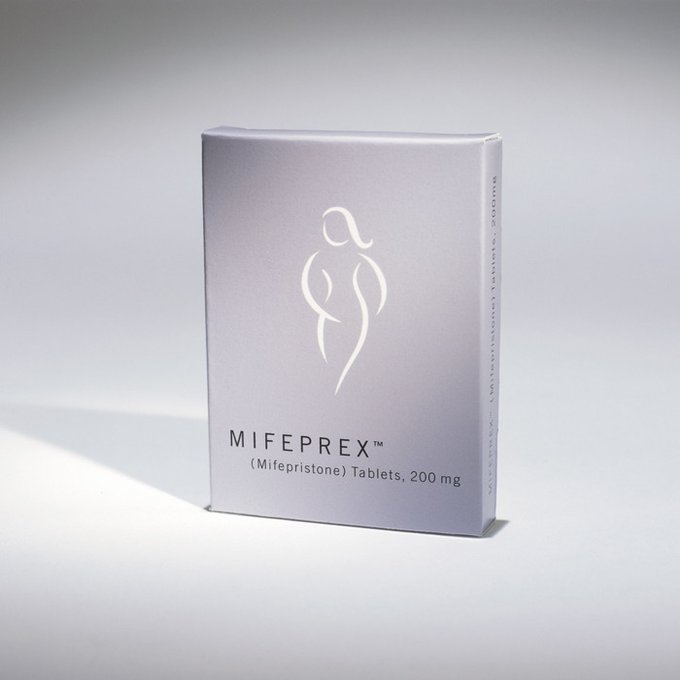Medications can be used to perform #latetermabortions. The Abortion Pill Procedure consists of combining #mifepristone and #misoprostol to terminate pregnancies in the first trimester (3 to 14 weeks), second trimester 14.1 to 28 weeks) and... t.ly/NVHX

CDC report shows abortion pill is being prescribed past FDA limits
Abortion Pill·By Carole Novielli
CDC report shows abortion pill is being prescribed past FDA limits
The abortion pill is likely being prescribed past the approved U.S. Food and Drug Administration’s (FDA) gestational limit of 70 days/10 weeks, which could result in failed abortions, according to the latest abortion surveillance published by the Centers for Disease Control and Prevention (CDC). This seems to confirm that bad actors within the abortion industry are openly flouting the FDA’s approved limit for the chemical abortion pill regimen by prescribing abortion-inducing drugs into the second trimester of pregnancy.
FDA’s Safety Requirements
In 2011, following the deaths of several women, the FDA implemented a Risk Evaluation and Mitigation Strategy (REMS) for the abortion pill, mifepristone. At that time, the drug had only been approved for use up to 7 weeks of pregnancy in a regimen along with the drug misoprostol.
Then, in 2016, the Obama administration FDA weakened the REMS by removing the requirements that women or teen girls take the first drug in front of a clinician, in-person, at the location of a certified prescriber. The FDA also removed a requirement that the manufacturer report the drug’s non-fatal adverse events (complications), and the drug’s allowed use was extended for use on preborn children up to 10 weeks (70 days) of pregnancy.
While the 10-week limit remains in effect to this day, the Biden Administration has expanded use of the drug regimen by permanently allowing the drug to be shipped by mail and more recently gutting the REMS further by announcing it would allow retail pharmacies to dispense the drug, which they have begun doing, according to the generic manufacturer, GenBioPro.
The FDA left the policing of safety regulations in the hands of the manufacturers of the drug, who benefit from failing to de-certify all bad actors.

Abortion Totals Reported to CDC
The most recent CDC report, dated November 24, 2023, documented a total of 625,978 abortions reported to the CDC from 48 reporting areas in 2021. More recent data published October 2023 by #WeCount has estimated that 1,072,240 preborn babies were killed by abortion between June 2022 and June 2023. This includes 88,600 committed by virtual-only abortion pill dispensaries.
“Increases in chemical abortions are playing a large role in the abortion increase,” wrote Dr. Michael New, an assistant professor at the Catholic University of America and a senior associate scholar at the Charlotte Lozier Institute.
There are no federal mandates to report all abortions.
“[F]ederal abortion-reporting standards remain weak, and there are serious concerns about the reliability of CDC abortion data. The CDC did not report 2021 abortion data from California, Maryland, New Hampshire, and New Jersey. In fact, the CDC has not reported any data from California since 1997 and has not reported data from Maryland or New Hampshire since 2006. Furthermore, other states failed to report data about late-term abortions or the demographics of women who obtain abortions. Still others failed to provide specific statistics about chemical abortions or surgical abortions,” Dr. New wrote.
Overall Abortion Pill Numbers
In 2021, the CDC recorded a total of 565,312 “medication” abortions, of which 299,449 were recorded at or below nine weeks of pregnancy and 17,155 were recorded at greater than 9 weeks gestation.
In 2021, CDC recorded abortions by method type from 46 reporting areas as follows:
53.0% of abortions were early [abortion pill] medication abortions (a nonsurgical abortion at ≤9 weeks’ gestation),
37.6% were surgical abortions at ≤13 weeks’ gestation,
6.4% were surgical abortions at >13 weeks’ gestation, and
3.0% were [abortion pill] medication abortions at >9 weeks’ gestation;
other methods, including intrauterine instillation and hysterectomy/hysterotomy, were rare (<0.1%)
“Early medication abortion is defined as the administration of medications (typically mifepristone followed by misoprostol) to induce an abortion at ≤9 completed weeks’ gestation, consistent with U.S. Food and Drug Administration (FDA) labeling for mifepristone that was implemented in 2016,” CDC wrote.
“CDC’s category of ≤9 weeks’ gestation includes abortions through 9 weeks and 6 days. Medications (typically serial prostaglandins, sometimes administered after mifepristone) also might be used to induce an abortion at >9 weeks’ gestation,” the CDC clarified.
Article continues below
Dear Reader,
In 2026, Live Action is heading straight where the battle is fiercest: college campuses.
We have a bold initiative to establish 100 Live Action campus chapters within the next year, and your partnership will make it a success!
Your support today will help train and equip young leaders, bring Live Action’s educational content into academic environments, host on-campus events and debates, and empower students to challenge the pro-abortion status quo with truth and compassion.
Invest in pro-life grassroots outreach and cultural formation with your DOUBLED year-end gift!
Big Abortion Flouts FDA Limits
The Food and Drug Administration (FDA) has only approved dispensing the abortion pill mifepristone safely through 10 weeks, or 70 days. At later gestational ages, the failure rate increases, often drastically, which can potentially result in greater complications for the woman.
In addition to prescribing the drugs past 70 days, a series entitled “Bad Actors” published by Live Action News documented that the abortion industry is instructing women to take the drugs off-label, is failing to properly date a pregnancy or rule out dangerous ectopic pregnancy before prescribing the drugs, is spending little to no time at follow-up, is scheming to hide abortion pill related complications, and much more.
Yet, according to the latest CDC report, chemical abortion pills “accounted for 70.6% of abortions at ≤6 weeks’ gestation, 61.6% of abortions at 7–9 weeks’ gestation, 20.6% of abortions at 10–13 weeks’ gestation, 1.3%–3.1% of abortions at 14–20 weeks’ gestation, and 12.3% of abortions at ≥21 weeks’ gestation.”
The CDC recorded a total of 470,157 abortions reported by both method type and gestation. Out of those, 266,454 were categorized as “medication” abortion:
253,278: at or less than 9 weeks gestation.
12,231: 10-13 weeks
158: 14-15 weeks
122: 16-17 weeks
207: 18-20 weeks
458: at or above 21 weeks.
What this means is that of abortions recorded by the CDC which were done by mifepristone past the FDA approved limit of 10 weeks, nearly 1,000 were reported at gestational ages above 13 weeks. As the CDC does not breakdown the 10-13 week category, we have no way of knowing whether all or some of the 12,000 chemical abortions recorded there were past the approved 10-week limits.
Abortion Pill Increases
According to the CDC’s 2021 data, the percentage of chemical abortions increased nearly five percent (5%) from 53.4% in 2020 (291,890) to 56.0% in 2021 (565,312).
“As a matter of comparison, chemical abortions were only 31.6% of the total in 2016,” Dr. Michael New wrote.
A review of just the 37 reporting areas which provided continuous data and included medication abortion on their reporting form during 2012-2021, the CDC found that “use of early medication abortion increased 3% from 2020 to 2021 (from 50.6% to 52.3% of abortions) and 137% from 2012 to 2021 (from 22.1% to 52.3% of abortions).”
“Public policy plays an important role in the incidence of abortion. The Biden Administration FDA continued [its] COVID-era policy of allowing women to obtain chemical abortion drugs without an in-person medical exam. This made abortion policy more permissive and likely contributed to the abortion uptick,” Dr. New wrote.
Abortion Pill Use Hits 6 million Since 2000 Approval
The abortion pill was first approved by the FDA in 2000, and while CDC data is limited to states that require any abortion reporting, under REMS, the manufacturers of the abortion pill mifepristone (Danco and GenBioPro) are required to report total abortion pill sales to the FDA.
That data, provided to the FDA through the end of December of 2022, showed that, since 2000, the estimated number of women who have used the abortion pill mifepristone in the U.S. for “medical termination of pregnancy” has now reached 5.9 million.
In addition to the increase in babies targeted by chemical abortion, the FDA reported 32 deaths “associated with mifepristone” since its approval in 2000. “The FDA has received reports of serious adverse events in patients who took mifepristone. As of December 31, 2022, there were 32 reports of deaths in patients associated with mifepristone since the product was approved in September 2000, including two cases of ectopic pregnancy (a pregnancy located outside the womb, such as in the fallopian tubes) resulting in death; and several fatal cases of severe systemic infection (also called sepsis),” according to the updated numbers published on the FDA website on September 1, 2023. “The adverse events cannot with certainty be causally attributed to mifepristone because of concurrent use of other drugs, other medical or surgical treatments, co-existing medical conditions, and information gaps about patient health status and clinical management of the patient,” the FDA also noted.
Live Action News is pro-life news and commentary from a pro-life perspective.
Contact editor@liveaction.org for questions, corrections, or if you are seeking permission to reprint any Live Action News content.
Guest Articles: To submit a guest article to Live Action News, email editor@liveaction.org with an attached Word document of 800-1000 words. Please also attach any photos relevant to your submission if applicable. If your submission is accepted for publication, you will be notified within three weeks. Guest articles are not compensated (see our Open License Agreement). Thank you for your interest in Live Action News!
Read Next

Vietnamese Catholics widen support for pregnant mothers
Angeline Tan
·More In Abortion Pill

Human Interest
She instantly regretted taking the abortion pill. Then one pro-life sign changed everything
Andrea Trudden
·
Abortion Pill
This eBay store is selling the abortion pill, putting women in danger
Carole Novielli
·
Abortion Pill
'Destructive of state sovereignty': Louisiana sues to block mail-order abortion pill expansion
Carole Novielli
·
Abortion Pill
Florida and Texas re-file lawsuit challenging abortion pill
Carole Novielli
·
Abortion Pill
South Dakota AG tells abortion pill advertiser to 'cease and desist'
Bridget Sielicki
·More From Carole Novielli

Abortion Pill
This eBay store is selling the abortion pill, putting women in danger
Carole Novielli
·
Abortion Pill
'Destructive of state sovereignty': Louisiana sues to block mail-order abortion pill expansion
Carole Novielli
·
Investigative
Pregnancy centers continue to surpass brick-and-mortar abortion businesses
Carole Novielli
·
Abortion Pill
Florida and Texas re-file lawsuit challenging abortion pill
Carole Novielli
·
Investigative
Former Planned Parenthood staffer describes how women were coerced and misled
Carole Novielli
·